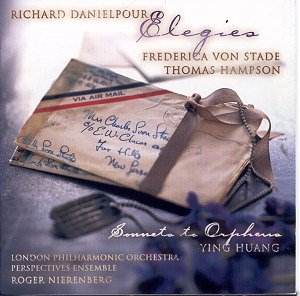To the best of my knowledge this is the third CD released by SONY entirely devoted to Richard Danielpour's music and the first one to include some of his vocal music.
The genesis of Elegies completed in 1997 is worth telling for the circumstances of the commission are somewhat unusual. Frederica von Stade's father was killed in Europe during World War II, a few months before Frederica's birth. Many years later, she found a bundle of her father's letters, lost them and found them again. She then formed an idea of a work based on these letters. A conversation with Roger Nierenberg, musical director of the Jacksonville Orchestra, let to a joint commission to the writer Kim Vaeth and to the composer Richard Danielpour. So, Vaeth devised poems based on von Stade's letters. Danielpour set them for mezzo-soprano (the girl), baritone (the father) and orchestra. This substantial "song cycle" falls into five sizeable sections. Vigil opens with tolling bells creating an ominous mood. The girl sings her longing to touch the spirit of her father. The coda is introduced by a restatement of the tolling bells motif and ends softly. In the second section Lacrimosa the music evokes the horrors of death with some martial, brutal, reckless music which pauses for the father's plea "Where is my beloved". The girl's tender reply is unheard by the father who repeats his questioning. The "war music" is recalled in the coda. The next section Benediction is a tender song in which the father imagines the course of his unborn child's life. In the fourth section Litany the girl invokes her father's spirit again. Her meditation is interrupted by a nervous interlude recalling the earlier "war music". This fades away and father and daughter are at long last united in "soft, closely matched musical lines". This section ends with a peaceful coda. The last section In Paradisum sings the hard-won serenity of the girl. Elegies is a beautiful and moving work that is likely to earn Danielpour many new admirers for he has a sure sense of orchestral colours and his vocal writing is eminently singable, unashamedly melodic, generally syllabic with few word repetitions, almost straightforward though supple and subtle throughout. Frederica von Stade and Thomas Hampson sing beautifully and are superbly supported by the LPO and Roger Nierenberg.
Though written for smaller forces, Sonnets to Orpheus, completed in 1992, is another substantial piece of music. The scoring is for chamber ensemble and is characterised by important parts for piano, cello and horn (the latter is almost "Brittenish"). This settings of Rilke's sonnets in an English translation by Stephen Mitchell already displays all the characteristics of Danielpour's song writing mentioned earlier, but the piece as a whole is more varied for the mood of the individual sonnets is far more contrasted. The Prologue opens with a declamatory horn invocation followed by a thoughtful song of the cello. It ends with a short coda restating the opening horn and piano music accompanied by softly tolling bells. The next section Dance the Orange is in the nature of a Scherzo in the form of a disturbing tango moving into a syncopated dancing, jazzy movement. A restatement of the tango material is followed by a brisk coda ending abruptly. This humorous, slightly ironic movement is followed by Elegy, a beautiful song in which the soprano is accompanied by delicate textures, again with a prominent, dreamy horn part. Quite appropriately Tarantella is another Scherzo in dance form. Its scoring with whooping horn and some percussion effects is irresistible, though again it has more than one touch of irony. In total contrast again, Anthem is a beautiful song-like meditation, a deeply moving lament from which the music builds towards an impassioned climax dissolving into a tranquil, ecstatic concluding Nocturne. In the last section Epilogue the mood is now elegiac expressing a resilient surrender to Death. This song serves as a peaceful coda to the entire cycle. In Sonnets to Orpheus Danielpour's imagination was obviously fired by Rilke's words and the result is a superbly crafted cycle full of subtlety, variety and contrasts reflecting the varied moods of Rilke's poems. This work is well served by Ying Huang's light and supple soprano voice which floats over the instruments.
As already mentioned Richard Danielpour's music is clearly of its time, but it is always superbly crafted, as is the music of some other American composers such as Piston, Mennin or Barber. It is always directly communicative, accessible and generally avoids extremes. Even more violent, dissonant episodes are strictly kept under control almost in a classical manner. In these pieces, Danielpour's word setting often recalled Barber's in its simplicity and flowing lines (and the music in Epilogue from Sonnets to Orpheus echoes Barber's Violin Concerto).
In short, if you respond to the music of Barber, Mennin or
Piston you can not fail to respond to Danielpour's beautifully crafted
music and you will find much to relish in these two substantial song
cycles which are really well worth investigating and which vastly repay
repeated hearings.
Hubert CULOT

![]() Frederica von Stade (mezzo-soprano);
Thomas Hampson (baritone); London Philharmonic Orchestra; Ying Huang (soprano)˛;
Perspectives Ensemble˛; Roger Nierenberg
Frederica von Stade (mezzo-soprano);
Thomas Hampson (baritone); London Philharmonic Orchestra; Ying Huang (soprano)˛;
Perspectives Ensemble˛; Roger Nierenberg![]() SONY SK 60850 [65:27]
SONY SK 60850 [65:27]